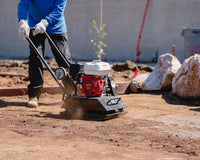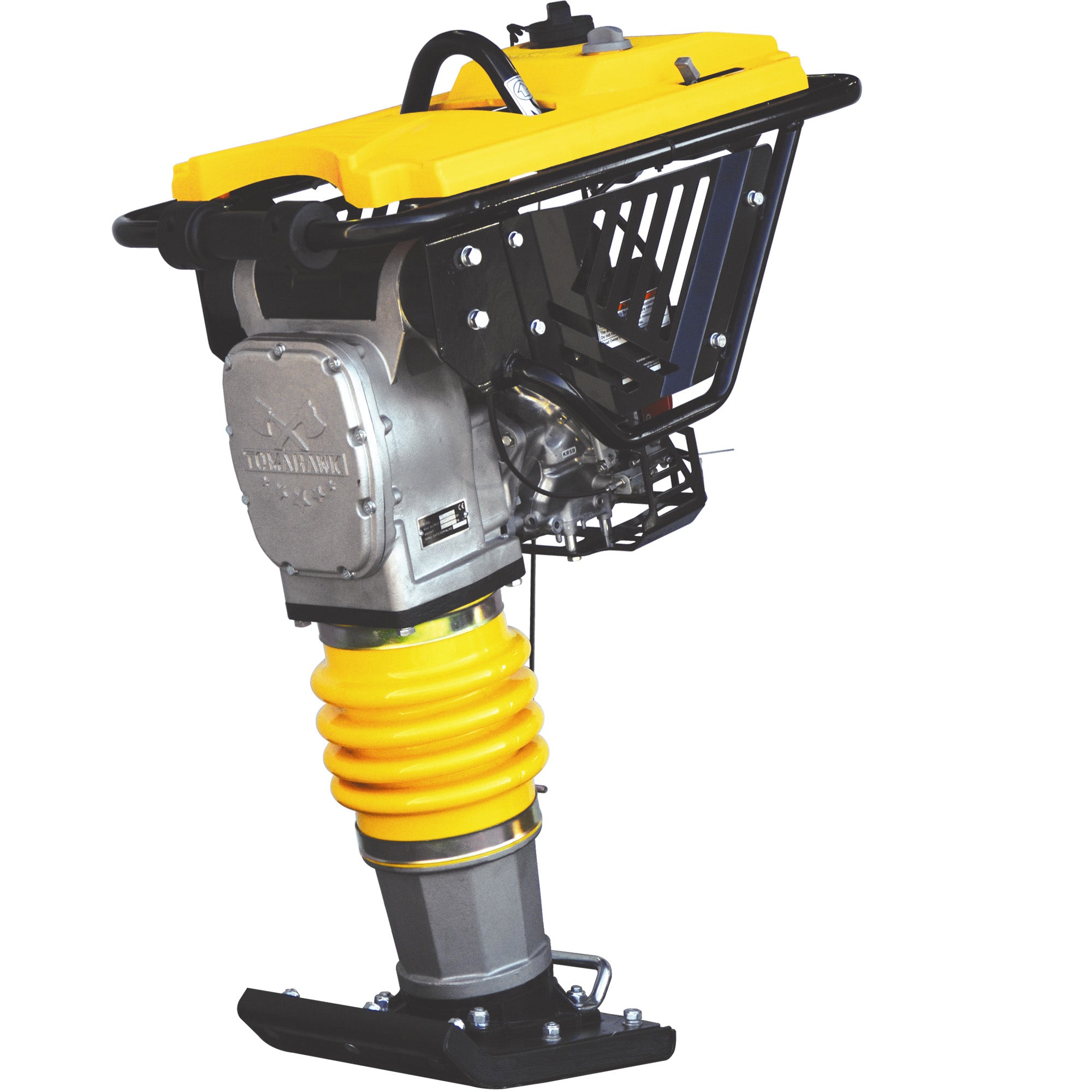How to Troubleshoot A Plate Compactor: A Complete Guide
Plate compactors, also called vibratory plates, are designated for cohesive and granular soils, as well as asphalt. Plate compactors are an essential tool for soil compaction in the construction industry. Whether you are building a sidewalk or compacting asphalt, there may be problems starting up your vibratory plate, costing you time and money.
Plate compactor engines work with gasoline or diesel fuel moving the plate’s heavy assembly weight at a high vibration speed to develop compaction force. As a result, these vibrations cause forward movement. As a rule of thumb, the heavier the plate, the more compaction force is generated. The average frequency of a vibratory plate ranges from 2500vpm to 6000vpm (Vibrations Per Minute). Due to the nature of the equipment, it is not uncommon for plate compactors to have complications after excessive vibration.
The bulk of your troubleshooting will focus around two areas: The engine and the belts. We recommend monthly and even daily checks to make sure your compactor is running smoothly.
We will guide you through a few quick maintenance tips to help you repair common plate compact or issues:
Common regular checks for plate compactors
- Check the fuel: Check if you have enough gas and oil in your plate compactor. Additionally, if the hydraulic fluid looks opaque or discolored, we would recommend to change it immediately.
- Note: Keep your plate compactor on a flat surface before checking gas, oil, and hydraulic fluid levels
- Perform a “Hands-on” inspection: Make sure all equipment components are tightened. Vibration may have loosened parts including the spark plug, air filter, and belt.
- Wash plates: To avoid accumulation of dirt and other material, clean your compactor’s plate and check if the engine has any accumulation of dirt.
- Note: It is not recommended to use a pressure washer to clean as this may cause damage to the engine. Using pressure washers could result in an overall shortened life of your machine.
- Clean fuel tank: Before storing or transporting the plate compactor, drain the gas and oil tank. If operating under a heavy load or high temperatures, drain it more often.
- Note: Never remove remains of fuel while the engine is running.
- Check the battery: Make sure the connections are not loose. It would be safe to lubricate the poles with electrical grease for better connectivity and avoid the accumulation of acid on your battery.
Common Issues
Next, let’s look at common plate compactors issues and their solutions:
A. Engine will not start or will not stay running:
- Follow proper starting procedures listed in the Operations Manual.
- Check the engine switch: If the switch is set to “OFF”, switch it to “ON”.
- Oil and Gas: Use 91 Octane Gas and clean SAE 10W-30 oil.
- Fuel valve: If the fuel valve is turned “OFF”, then turn to the “ON” position.
- Fix choke: If the choke is open, we recommend closing the choke.
- Control fuel levels: If engine is out of fuel, add gasoline and/or oil.
- Clean engine: Change the gasoline in the gas tank. Old gasoline may affect engine power.
- Air Filter: Check the air filter for any dust clogging. This can reduce engine performance. Clean or replace if needed.
- The spark plug misfires: Clean up the spark plug and/or replace it in case that it looks worn.
- Plate compactor is not on a level surface: To prevent low oil shutdown from triggering make sure your plate compactor is on a level surface.
- Check the oil sensor: The cable may have shifted in transit and not accurately read oil levels – Unplug the oil sensor, which is the yellow cable.
B. Engine is running but there is no vibration:
- Check handle lever: If the handle is set to “MIN”, move handle lever to “MAX”.
- Drive belt is loosened or broken: Fix or replace immediately.
- The oil level on the exciter box may be low or possibly even too full. Remove the exciter box’s drain plug screw while on a level surface. If there is too much oil the exciter will not have enough air to move. If there is a burning smell or smoke, you may need to add oil as this could be the exciter box gears.
C. Engine lacks power:
- Follow proper starting procedures listed in the Operations Manual.
- Oil and Gas: Use 91 Octane Gas and clean SAE 10W-30 oil.
- Clean or change your carburetor: A dirty carburetor may result from from bad fuel, debris build up, low octane, and/or ethanol build up, making your carburetor go bad. Use carb cleaner to clean debris effectively. Also consider using a micro-sonic cleaner (jewelry cleaner) to effective clean all gunk or build up on the inside of the carburetor.
- Check the clutch: Inspect, clean, and/or replace if needed.
- Check the drive belt: the belt may be loose or broken.
D. Plate compactor is hard to control or compacts unevenly:
- Check the speed: Make sure the throttle speed is not too high by adjusting the engine throttle.
- Ground surface is too hard: In some instances, the soil is too hard, or has reached a maximum level of compaction. Test and check the soil’s compaction level.
- Rubber isolator is damaged or loosened: Replace it immediately.
- Vibration mounts: replace if damaged or worn.
E. Poor performance:
- Check throttle: If it is not completely opened, adjust as needed.
- The engine speed is low: Use a tachometer and adjust or repair the engine.
- Reduced engine performance: Air filter may be clogged with dust. Clean or replace the air filter cartridge.
F. Soil is difficult to compact:
- Moisten the soil: Use a garden hose to water the soil.
- Test the soil: Squeeze a handful of soil with your hand and drop it on the ground. Observe whether the soil breaks apart when dropped. If the soil does break apart, it means that it is too dry. If the soil keeps together in one piece when dropped, it is ready for compaction.
Maintenance
Proper maintenance of your plate compactor will preserve the life of your machine.
Following these tips on maintenance, you will help ensure your equipment will run smoothly throughout the busy season.
There are three main parts within plate compactors that have the most common problems: the engine, drive belt, and/or spark plug.
Overall, engine manufacturing is an essential factor when keeping your plate compactor running for a long time. Well-known brands such as Honda, Kohler, Subaru, and Tomahawk Power are built with the best materials for long lasting products. Additionally, they can easily be serviced around the United States. Nevertheless, other engines on a global level may be cheaper, but have an overall lower quality - causing you issues in your near future such as engine issues and job site stoppage.
Once you become familiar with conventional troubleshooting techniques, it is easier to keep track of your plate compactor maintenance. Avoid complications that could leave your job site stopped with these guidelines. We recommend understanding what engine is powering your machine. Based on the manufacturer’s warranty and its quality, you will be able to make informed decisions.
Additional Questions
- How do I attach a wheel kit to my plate compactor?
Make your plate compactor portable with Tomahawk Wheel Kits. Smooth-rolling never-flat tires make it easy to transport your plate compactor to and from the jobsite. Fitting both Honda and Kohler TPC80 models, add functionality and portability to your plate compactor with this easy-to-install wheel kit.
Learn how to attach a wheel kit on a plate compactor here:
- What is the Poly Pad for?
Paver Pads, also known as poly pads or polyurethane pads, are great for the compaction of concrete pavers and bricks, for outdoor patios, driveways, and more. Of course you can also use your vibratory plate without a pad, but you will find many more broken or scratched bricks as a result.
Learn how to attach a poly pad on a plate compactor here:
Glossary
Tachometer: A tool that measures the working speed of an engine, typically in revolutions per minute.
Exciter: A battery that produces electric current to produce magnetic field in a machine or motor.
For more information on our Plate Compactors, visit the Equipment Resource Center.
Glossary
Compaction: The process of increasing soil density and stability by reducing air gaps through pressing or vibrating.
Vibratory Plate: Equipment used to compress various materials like soil and asphalt through vibrations.
Exciter Box: Contains a mechanism in compactors that generates vibrations needed for compaction.
Tachometer: Measures the operational speed of an engine, typically in revolutions per minute (RPM).
Carburetor: A device in an engine that mixes air with a fine spray of liquid fuel for combustion.
Hydraulic Fluid: Liquid used to transfer power within hydraulic machinery.
Spark Plug: A device for delivering electric current from an ignition system to the combustion chamber of an engine.
Drive Belt: A belt that transmits power from the engine to other components of the compactor.
Oil Sensor: Monitors the oil level in an engine to ensure proper lubrication.
Wheel Kit: An accessory used to add mobility to equipment like plate compactors, facilitating easier transport.













3 comments
road sweeping
Such a nice blog on how to troubleshoot a plate compactor and I hope you keep update us with such great tips and information in future too. This is a great post; I will share as much as I can. This https://www.scrubbingsolutions.co.nz/ is very useful and its related to what you have actually mentioned here
timber johnson
ok all sounds great but what about when the engine and drive belt are good the counter balance weights and oil level are good . how do you measure the frequency that the compactor produces and compare it to the specs ?
Leonard
I have had a crew finish a 1998 brick paver restore job, and they left on the adjacent driveway a strange pattern of circular marks, all in a long pattern of overlaping joined circles in the concrete. There are no deep scratches, just lighter lines of overlapping circles with 4 1/4 inch diameter totaling 5 feet. Is there some way the machine could have gone haywire if not controlled by the operator? Can some mechanical defect cause this? They never advised us of this problem, or neither when they broke a paver in some steps, and had no replacement available at two local suppliers. We believe the company was not observing the work enough on a $5510 job. We do not expect any repair, the marks are probably permanent.